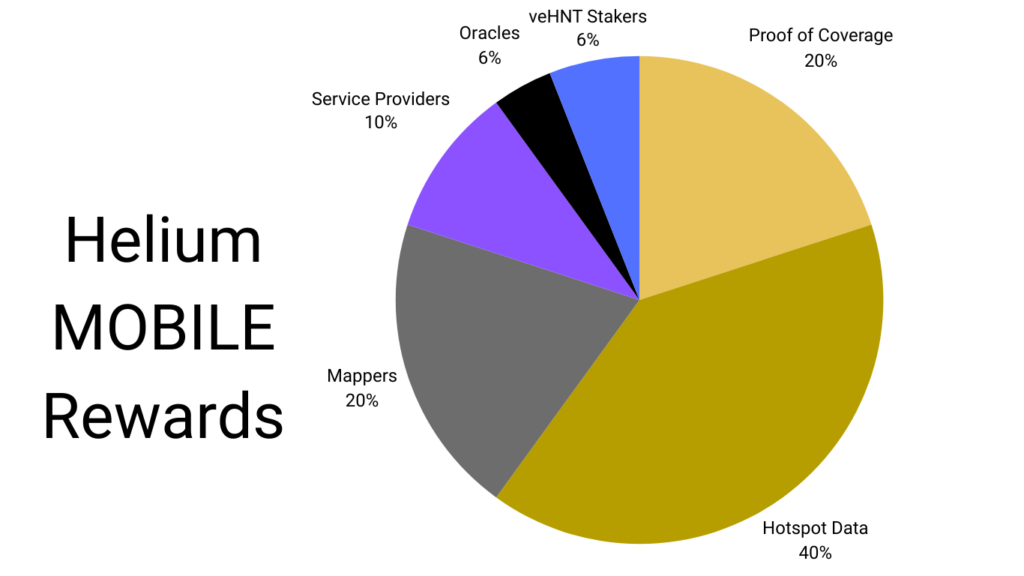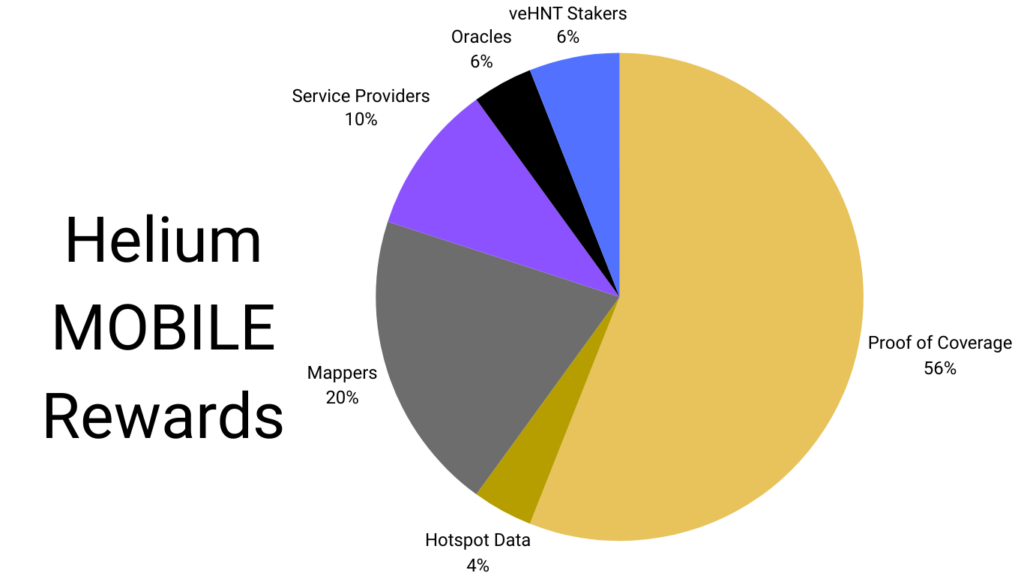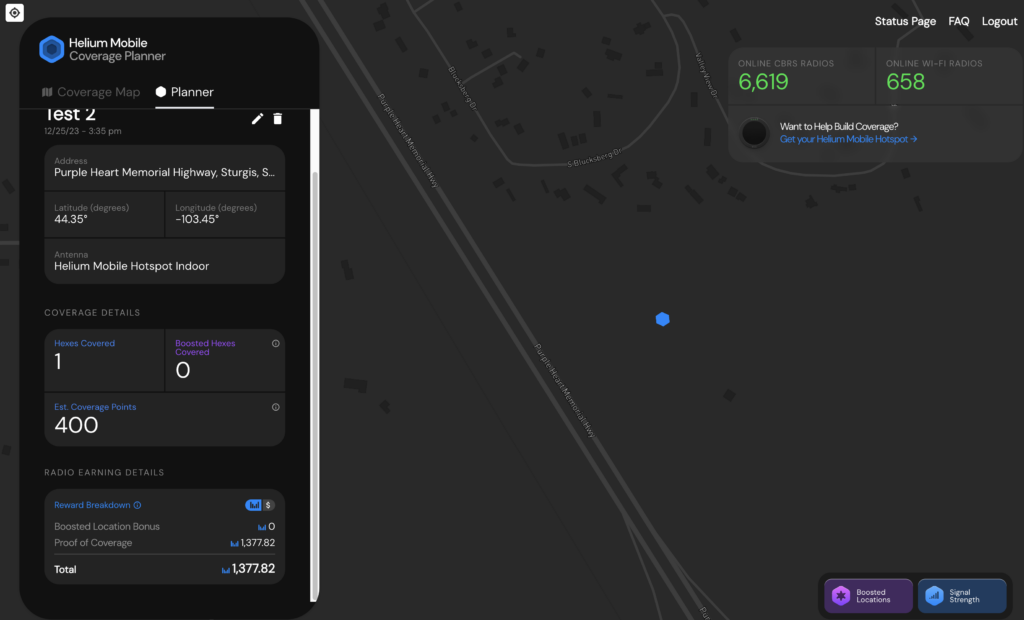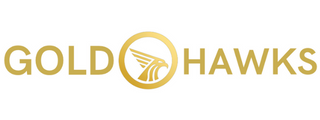Helium’s Mobile network (and corresponding $MOBILE token) has been developing for the past few years; it’s not a particularly new thing. Still, it started attracting serious notice in the past few weeks after the first bump in the crypto market convinced many people that the bull market is coming, and it might be time to get serious about earning tokens.
In very broad strokes, the Helium MOBILE ecosystem allows you to deploy wireless coverage and use it, getting paid in tokens for both.
That begs the most common question we hear about Mobile:
“How do I earn the most tokens for participating?”
We’ll be writing a few posts on this; it’s a big topic. In this first one, we’ll be covering some important strategic aspects in the journey to where we are by walking through a few of the HIPs (Helium Improvement Proposals) that have shaped rewards. If you want to skip to how to deploy Helium Mobile radios to earn tokens, go to this post.
From the 30,000′ view, there are really two ways you can earn: By mapping coverage, and deploying coverage. Mapping is mostly a “0 or 1” game: Make sure you have Helium Mobile Discovery mapping enabled, then move around with your phone. It ain’t rocket surgery.
Deploying coverage is a bit more tricky. You need to think about what you should deploy, and where, and exactly how.
Let’s dive into the various HIPs that describe how you can earn the most and why. My business partner Max Gold wrote or helped write most of these HIPS, and our consulting firm currently holds a contract to help structuring incentives at Helium Mobile.
You probably won’t find someone who understands the incentives themselves better than Max. With that said, anyone who’s willing to read through all the HIPs, watch the Mobile Working Group calls and read through a few Discord channels has access to the same information.
At a high level, any good incentive structure will reward users for providing the most value to the network. Helium MOBILE is no different, and as new features roll out the incentives and structure continue to evolve to encourage users to build a robust and useful network for cell phones.
While there a bunch of factors that go into what any given Hotspot will earn, if you want to skip to the high level end, it comes down to this: Place your radios, whether they are indoor or outdoor, WiFi or CBRS, in a place where a boatload of people will be using their cell phones.
Let’s review how we got there, starting at the beginning, with HIP 53. HIP 53 provides a broad strokes overview of how the MOBILE subDAO (subordinate to the Helium DAO) works, including where rewards go.
The breakdown for token emissions for the Helium Mobile subDAO looks like this:

- 20% of all MOBILE rewards go to PoC, or Proof of Coverage
- 40% go to Hotspots Data
The 20% going to PoC is a little misleading; 20% is the minimum that will go to it.. The lion’s share of rewards (20 + 40 = 60%) goes to providing and using coverage. 40% is the upper limit of what can go to Hotspot Data. Let’s say in the beginning we don’t use all the Hotspot Data tokens, but only a few of them. That might look like this:

Any $MOBILE tokens that don’t go to reward data transfer gets shifted to PoC. Does that get ya fired up about deploying radios?
That doesn’t mean no data will ever pass; in this tweet from Nova CEO Amir Haleem we’re already seeing multiple terabytes of data flow through the network on a daily basis.

Ok, what about the rest of it?
- 20% to go Mappers (originally 10%, but that changed in HIP 79)
- 10% to Service Providers
- 4% to Oracles
- 6% to veHNT Stakers
What does that mean for you, as a deployer who wants to maximize your earnings? Focus your efforts on proving your coverage (PoC) and providing coverage (Data) in a place where people need it.
We’ll start with HIP 74, which defines rewards for *potential* coverage. For now, $MOBILE is only available in the US, so we’ll be using freedom units to describe distances and areas.
The location coverage resolution is defined by a res12 hexagon. The res12 size comes from the Uber H3 geospatial system. A res12 is about 60′ across and right around 3,200 sq ft in area.
That’s the size of a regular 3 or 4 bedroom house in the Midwest, here’s one courtesy of Max House Plans.

If you live in any of the major cities in California, it might help to think of it as the size of the properties 2 streets in from the ocean in any beach town. Either way, it ain’t that big.
Now, HIP 74 is about *potential* coverage. Given where a radio is and what its signal strength should be, HIP 74 assigns “coverage points” to a radio. Radios comes in three types and two wireless protocols.
Types: Indoor, Outdoor, and Outdoor High Power.
Protocols: CBRS and WiFi
There isn’t an “Outdoor High Power” WiFi unit, just Indoor and Outdoor.
Each one earns different levels of coverage points for the res12 hexes it should cover.
As a VERY general rule of thumb, as of late 2023, you’ll earn the most with a well-deployed High Power Outdoor CBRS unit. This will change if HIP 101 passes, and earnings will be more equalized. If you want to see a list of radios and earnings comparisons, check out our Rough Guide to Helium Mobile.
Once HIP 101 passes, WiFi units will probably earn more per dollar spent as they’re cheaper and easier to deploy.
HIP74 limited any given res12 to reward coverage to only 5 radios, depending on estimated signal strength, how fast they transmit data, and how long the radio has been providing coverage (the longer the better.)
We’ll skip ahead to HIP 85 for a bit, just to show that buying 5 outdoor radios and just leaving ’em all pointed in the same direction because that’s convenient for you (but not good for the network) won’t earn anywhere near as much as if you deploy those 5 well.
HIP 85 ranks CBRS radios based on their Modeled Signal Strength. It also cuts the number of radios that can earn a reward to 3, from 5.
If you’ve ever deployed one of these outdoor CBRS radios, you know that part of the setup is reporting what you’ve done to the FCC via a CPI (Certified Professional Installer). This includes where the radio is (coordinates and how high) as well as which way it’s pointing (direction and angle).
Once you know those, you can start to model out coverage much more accurately. You can also significantly reduce rewards for a bunch of radios all providing the same or seriously overlapping coverage. You can use Helium’s planning tool to estimate what kind of coverage and rewards you might get for any given deployment.

We’ll go deeper into planning in our next post, but for now let’s stay on track so you get the big picture.
HIP 85 rewards the top 3 radios in terms of signal strength for providing coverage. It’s important to remember that HIP 85 only applies to CBRS radios; NOT the WiFi hotspots.
Obviously you can’t just reward for what you *think* coverage will be; you’ve got to prove it. That’s where HIP 79 (for mappers) comes in, which changed the original 10% set aside for Mapping rewards to 20% and creates progressively greater incentives to map areas that haven’t been mapped, but only once we have specialized mapping devices. For now, mapping remains a “ya get it or ya don’t” reward, there are no bonus points for being an extra good mapper.
As stated in Hip 79, “ the purpose of mapping is to verify or invalidate modeled coverage.” This is obviously valuable to the network, so another way to earn beyond just deploying coverage is to map that coverage. Mapping can happen either with a mobile phone subscribed to Helium (this is called Discovery Mapping) or, in the future, with a Mapper specifically built to assess coverage.
Ok, so now you know where coverage is and isn’t; the next step if you’re a Service Provider (cell phone company) is to say “Hey, I want to provide coverage where people are but coverage isn’t.” How do you do that? With Hex Boosting, which is laid out in HIP 84, the majority of which was written by Max.
A Service Provider can pay $.005 (half a penny) per multiplier per res12 hex per month. The minimum amount of time for a boost is 6 months. Let’s give 2 examples:
First, the lowest end: A Service Provider wants to boost 1 res12 hex by 2x for 6 months, that’ll cost $.005 x 2 x 6 = $.06.
Let’s say we have a Service Provider who wants to cover a square block in the San Diego neighborhood of Normal Heights where the world famous Paleo Treats store is located. That’s about 26 res12 hexes. If the Service provider decides they want to really incentivize this, they may boost by 8x for 6 months.
That’ll cost them $.005 x 26 x 8 x 6 = $6.24. Any radio that then deploys into that area earns 8x what they’d normally earn. As of late 2023, the only place being tested for boosting is Miami; you can see exactly where via the purple hexes here:

If you’re considering deploying a radio, you can explore Mobile coverage over on the Helium planning site to see if you’re near a boosted area, or already have coverage wherever you are.
The hidden gem in MOBILE boosting is that it drives value into the token. Service Providers need to buy $MOBILE in order to boost a hex.
That brings us to HIP 96, which defines the onboarding fee for WiFi Hotspots. As the authors of this HIP, we have shown that onboarding fees are superb ways of driving value into the network (manufacturers have to pay an onboarding fee to add hardware) as well as protect a network against bad actors who may maliciously add a ton of hardware with no cost.
If you’d like to understand onboarding fees more, we have a detailed post about them here.
So, where does that leave you if you want to maximize your earnings by participating in the MOBILE network? Here’s how the incentives line up:
- Place your radios where they cover boosted hexes.
- Don’t place it in areas where there is already coverage.
- Use the planner for every single deployment if you want to estimate what you’re going to earn.
If you’d like our help with planning out your radio deployments you can book a consult with Max and I, here.

Leave a Reply